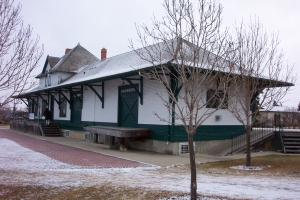When the Canadian Pacific Railway was planning for its continental line to the pacific coast during the 1870s, a favoured route saw the track proceeding northwest from Brandon, Manitoba through the Yellowhead Pass, crossing the North Saskatchewan River near the small Northwest Mounted Police community of Fort Saskatchewan. In the end, the CPR chose the Kicking Horse Pass, and the line was extended past Fort Calgary in 1883. Eight years later, a subsidiary of the CPR, the Calgary & Edmonton Railway, brought rail service directly to South Edmonton, and Edmonton soon emerged as a district metropolis.
In 1904, Edmonton became a city, and the following year it was named the capital of Alberta. As this was taking place, the city was making preparations for the arrival of the Canadian Northern Railway, which would give it a direct rail connection with eastern Canada.
Somewhat ironically, the route chosen for the Canadian Northern was roughly that selected for the CPR in 1877, except that, after passing by Fort Saskatchewan, it was made to swing southwest to include Edmonton. Fort Saskatchewan thus received a railway as early as the fall of 1905.

In anticipation of the arrival of the railway, Fort Saskatchewan began to grow rapidly. In July 1904, it became a town with over 500 people. It was, therefore, appropriate that the Canadian Northern construct a station befitting the largest community on its line between Edmonton and North Battleford. While rail construction proceeded, work WAS begun on a wood frame station according to a newly devised 100-19 plan, which called for a long, vertical building, with an upper floor to accommodate the station agents and their families. It was located just west of the town center and was completed in October, 1905. In its immediate vicinity, a large water tower and a Brackman-Kerr elevator were erected at the same time.
Being in the center of a rich farming district, Fort Saskatchewan continued to grow after the arrival of the CNoR. The railway bridge across the North Saskatchewan also served as a traffic bridge, giving the town direct automobile access to Edmonton some 20km away. Several other elevators soon dotted the skyline near the station, and a stockyard was located nearby.
The station, which included a telegraph office, continued to serve Fort Saskatchewan and its hinterland until the late 1980s. Declining rail traffic then warranted its closure and the re-location of the CN track away from the downtown core. From 1987 on, all passenger and freight connections were handled in Edmonton. The station survived however, due mainly to the efforts of the Fort Saskatchewan Historical Society, and a plan was worked out whereby CN sold the station and its immediate property, including some track, to the Province of Alberta and the Province immediately re-sold it toFort Saskatchewan, which had just become a city. In 1990, the old station was designated a registered historic resource, and, in 2008, it became a provincial historic resource.
Written by: David Leonard, Historian
Visit the Alberta Register of Historic Places to learn more about the heritage value of the Canadian Northern Railway Station in Fort Saskatchewan. In order for a site to be designated a Provincial Historic Resource, it must possess province-wide significance for either its history or architecture. To properly assess the historic importance of a resource, a historian crafts a context document that situates a resource within its time and place and compares it to similar resources in other parts of the province. This allows staff to determine the importance of a resource to a particular theme, time, and place. Above, is some of the historical information used in the evaluation of the Canadian Northern Railway Station.

